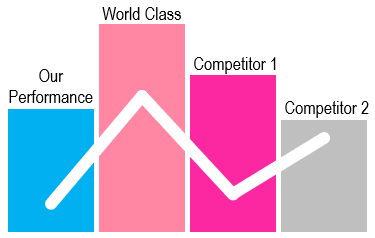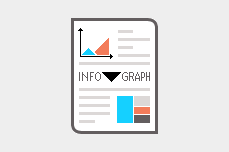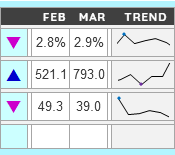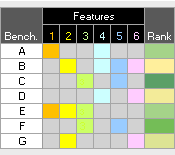
Also known as performance benchmarking and business benchmarking.
Variants include Best Practices Analysis, Comparative Analysis and Score-Carding.
Benchmarking is a systematic approach for measuring products, services, processes, and performance against high-performing organizations or other entities in order to understand and adopt their successful strategies and practices. It has become one of the common practices in the business world today with the purpose of learning from the best and continuously improving performance. Benchmarking should be viewed as one of the primary tools for achieving continuous improvement and therefore, should be integrated into quality and operational excellence activities.
Benchmarking is mainly used to better understand how outstanding companies operate. It involves the measurement of their strategies, practices, processes, and procedures and allows companies to gain valuable insights to improve their own. These companies can use such information to develop improvement plans and adopt specific best practices. Benchmarking helps in establishing quantitative improvement goals and is considered a valuable resource for various purposes, including designing, redesigning, and improving processes.
Types of Benchmarking
Benchmarking comes in two main types, external and internal.
External benchmarking can further be categorized as:
- Competitive, when the company compares its performance with direct industry competitors.
- Collaborative, if a group of companies carry out the benchmarking exercise collaboratively.
- World-class, when comparing with organizations that excel beyond direct competitors or industries. This involves studying industry leaders or organizations that best execute a specific function.

The following provides additional details for each type of benchmarking:
Strategic Benchmarking
- Benchmarking may be conducted at the higher level to assess strategic models and approaches.
- Aims to enhance the competitive advantage, performance, and overall strategic effectiveness.
Financial Benchmarking
- Aims to evaluate the financial health, efficiency, and effectiveness of the company in comparison with external entities by assessing key financial indicators such as profitability, liquidity and cash flow.
Product benchmarking
- The assessment of a product’s competitive position in comparison with industry benchmarks.
- Normally conducted during the design of new products or the upgrading of existing products.
Functional Benchmarking
- Aims to compare and analyze the performance, processes, and practices of the chosen function within a company against external benchmarks.
- Focuses on a single function such as human resources, purchasing or information technology.
Process benchmarking
- Involves process analysis and often focuses on aspects such as quality, efficiency, cost, and overall effectiveness.
- Allows to streamline and enhance processes that may span multiple functions.
Performance benchmarking
- A generic term, where all the previous types of external and internal benchmarking involve performance benchmarking.
- Aims to compare performance metrics and helps identifying areas for improvement.
Some types of benchmarking are not limited to a particular industry, which means that one can consider other industries when conducting a benchmarking study. For example, an electronic company can improve its inventory and supply chains processes by looking at how a logistics company handles its processes. Similarly, a healthcare facility can enhance patient appointment scheduling by exploring airline reservation systems. So, benchmarking can go beyond industry boundaries allowing companies to adopt successful practices from different sectors to improve their operations.

In recent years, Chinese businesses have actively adopted benchmarking to learn from global best practices and improve their own operations. This allows them to identify successful strategies, adopt cutting-edge technologies, and optimize their business models.
Data and Measurement
Data collection in benchmarking activities is essential as it allows for a thorough comparison with the selected benchmarks and provides valuable insights into the performance among the different entities. Collecting data, however, can sometimes be challenging due to various reasons such as difficulties in accessing relevant information, limitations in the availability of accurate and comprehensive data, complexities in data sources, and data privacy concerns.
Benchmarking data are typically gathered by internal teams within an organization, professional researchers, or consulting firms with expertise in the field. Additionally, there are many organizations who facilitate and provide benchmarking information for the public or for sale in a business setting. The Internet is also considered a valuable and free source of benchmarking data.

Identifying performance metrics before starting the benchmarking activity is important to ensure a focused, relevant, and measurable approach. Typical performance metrics often considered include defect percentages, customer satisfaction and retention levels, service response and cycle times, cost per unit or per order, and return on investment.
Conducting a Benchmarking Exercise
While there is no universally adopted benchmarking approach, the following guidelines can assist in conducting a benchmarking exercise:
- Form a dedicated benchmarking team.
- Determine the specific function, product, or process to be benchmarked.
- Identify relevant performance metrics for the benchmarking analysis.
- Identify data sources, partners, or companies for comparison.
- Utilize appropriate methods to collect benchmarking data.
- Determine current performance gaps and their root causes.
- Set goals and develop plans based on the analysis findings.
- Put plans into action to fill the performance gaps.
- Monitor progress continuously.
Note: Benchmarking can be performed as a one-time effort, but it is ideally conducted on a continuous basis. In such ongoing process, companies should continually strive to enhance their performance and practices, especially in the face of growing competition.

There are many tools available to assist in the presentation of the benchmarking data. One of the simplest tools involves using this benchmark summary report template.
Wrapping Up
Benchmarking is a powerful tool that empowers companies to learn from the best, set ambitious goals, and continuously improve. Whether applied externally for competitive insights or internally for organizational enhancement, benchmarking promotes excellence in the ever-changing business environment. Adopting benchmarking as a structured process can help companies achieve greater performance, innovation, and overall success.
References
Heizer, J., Render, P., & Al-Zu’bi, Z. (2013). Operations Management.
Brook, Q. (2020). Lean Six Sigma and Minitab: The Complete Toolbox Guide for Business Improvement.
Other Formats
Do you want to use the slides in your training courses?

Benchmarking Training Material – $14.85
Related Articles
Related Templates












